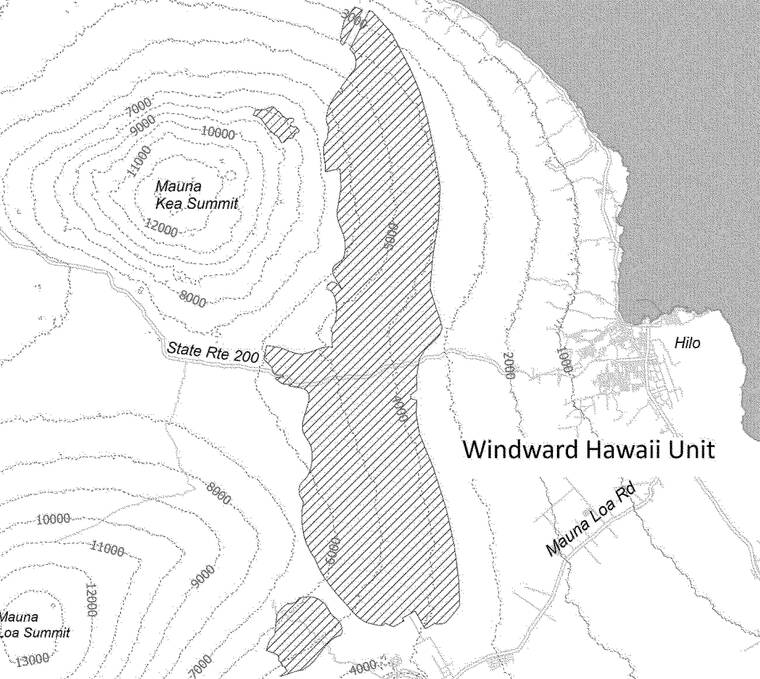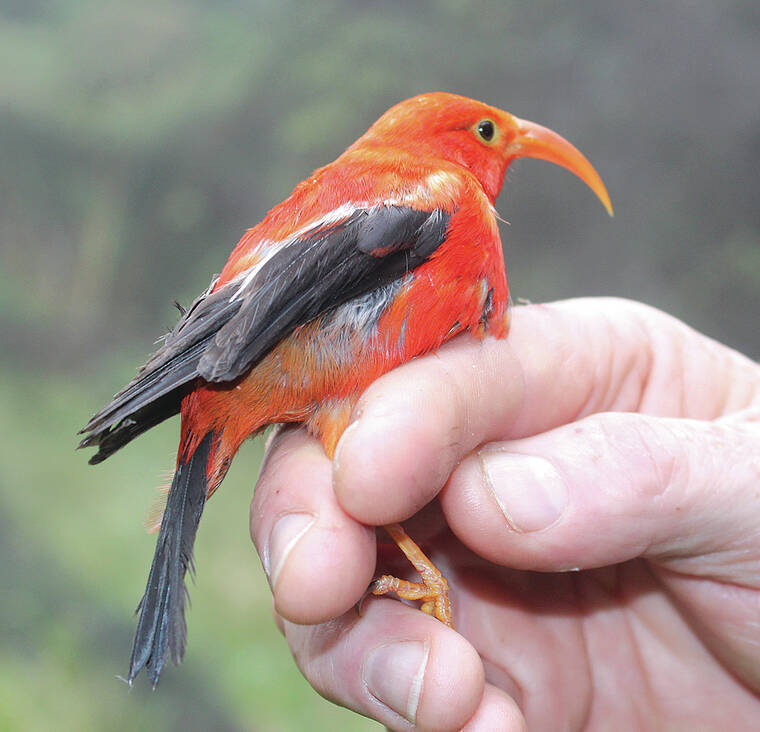Saving ʻiʻiwi: Feds propose critical habitat for threatened bird

The proposed South Kona Unit covers 51,376 acres on the west slope of Mauna Loa. In Ka‘u, 32,458 acres on the southeast slope of Mauna Loa are proposed for designation as critical habitat. (Map from Federal Register/Special to West Hawaii Today)

The North Kona Unit would consist of 13,599 acres, of which 3,029 acres overlap existing critical habitat. This unit consists of state lands (9,457 acres) within the Pu‘u Wa‘awa‘a Forest Bird Sanctuary, Pu‘u Wa‘awa‘a Forest Reserve, and Honua‘ula Forest Reserve, and some private lands. (Map from Federal Register/Special to West Hawaii Today)

As proposed, the rule would designate 238,518 acres on Hawaii Island as critical habitat for the ‘i‘iwi. More than half of that, some 141,085 acres, lies on the windward slopes of Maunakea and Mauna Loa. The unit is home to more than half of the ‘i‘iwi population in the state. (Map from Federal Register/Special to West Hawaii Today)

An ‘i‘iwi, or scarlet honeycreeper, is seen. (Megan Nagel/USFWS)

An ‘i‘iwi, or scarlet honeycreeper, is seen at Hakalau Forest National Wildlife Refuge. The refuge is among acreage proposed as critical habitat for the threatened species. (Dan Clark/USFWS)

An ‘i‘iwi, or scarlet honeycreeper, is shown. (USFWS/Pacific Region)
Nearly a quarter million acres on Hawaii Island are proposed to be designated as critical habitat for the federally threatened ‘i‘iwi, or scarlet honeycreeper.
Nearly a quarter million acres on Hawaii Island are proposed to be designated as critical habitat for the federally threatened ‘i‘iwi, or scarlet honeycreeper.
The designation for the ‘i‘iwi (Drepanis coccinea) will help focus federal, state, and local conservation efforts to manage and protect ‘i‘iwi, the U.S. Fish and Wildlife Service said in proposing the designation, which the agency must do after a species is listed as threatened or endangered under the Endangered Species Act of 1973.
ADVERTISING
“Designating critical habitat is an important step towards saving ‘i‘iwi,” said Lasha-Lynn Salbosa, Pacific Islands Fish and Wildlife Office Section 4 Classification team manager. “Mosquito-borne diseases like avian malaria remain the biggest threat to ‘i‘iwi and other native forest birds. Designation of critical habitat will allow greater access to tools for our federal, state, and other partners to manage and protect these species.”
Once considered one of the most common native forest birds across Hawaii, though historical abundance estimates are not available, the ‘i‘iwi today is known specifically on the islands of Hawaii, Maui, and Kauai, although small numbers of individuals may still be found on Oahu and Molokai. They are found only in higher elevation, closed canopy forests with native ohia and koa (Acacia koa) trees around 4,000 feet.
When the ‘i‘iwi was listed as threatened in 2017, an estimated 600,000 birds remained with 90% of those on Hawaii Island, and the remainder distributed between east Maui (about 10% ), and Kauai (less than 1%).
The medium-sized birds have scarlet feathers, black wings, and a long, curved, bright orange beak and are a favorite of amateur and professional ornithologists alike. The birds build nests primarily in ohia where they feed mostly on the nectar of the ohia blossoms.
The ‘i‘iwi is endemic to the Hawaiian Islands and faces many threats with mosquito-borne diseases, such as avian malaria and avian pox, both of which are carried by mosquitoes, being among its biggest threats, in addition degradation of the bird’s habitat, including the loss of its native host tree, the ohia lehua (Metrosideros polymorpha), and other threats including fire, drought and competition and predation by nonnative species.
To aid in the recovery of the ‘i‘iwi, the U.S. Fish and Wildlife Service proposed on Dec. 28, 2022, to designate not only acreage on Hawaii Island but also thousands of acres on Kauai and Maui, as well, as critical habitat for the bird. In all, the service’s proposal, published in the Federal Register, would designate more than 275,640 acres in seven sections with 60 subunits on the three islands as critical habitat for the bird.
The service will hold a virtual public information meeting and hearing on Docket No. FWS-R1-ES-2022-0144 from 6 to 8 p.m. Feb. 10. To register, visit www.fws.gov/project/iiwi-critical-habitat. Comments received or postmarked on or before Feb. 27 will be accepted, as well.
As proposed, the rule would designate 238,518 acres on Hawaii Island as critical habitat for the ‘i‘iwi. More than half of that, some 141,085 acres, lies on the windward slopes of Maunakea and Mauna Loa.
The state owns most of the “Windward Hawaii Unit” at 91,547 acres followed by the federal government at 34,694 acres with private landowners holding the remainder. Approximately 43%, or 60,777 acres, is within already designated critical habitat for species other than the ‘i‘iwi.
Designating the unit, which comprises nearly a dozen state and federal forest reserves, parks and refuges, is critical as the area’s montane forests are home to more than half of the ‘i‘iwi population in the state. A 2013 study found approximately 348,579 ‘i‘iwi, or 57.8% of the entire ‘i‘iwi population occupy the unit, according to the proposal. The area also boasts the highest ‘i‘iwi densities.
“This unit is essential for maintaining the species’ geographicalrange, contributing to the redundancy and representation necessary for its recovery,” the proposal reads.
In Ka‘u, 32,458 acres on the southeast slope of Mauna Loa are proposed for designation as critical habitat with about 17% of the land already designated for other species. State lands, including the Ka‘u and Kapapala forest reserves, comprise about 99% of the acreage with private landowners holding the rest.
The service says the area provides habitat connectivity between ‘i‘iwi that inhabit the proposed Windward Hawaii and South Kona units and is essential for maintaining the geographical range, redundancy and representation necessary for species’ recovery.
The proposed South Kona Unit covers 51,376 acres on the west slope of Mauna Loa. Nearly 35,000 of those acres belong to private owners and the remainder is split between the state and federal governments.
Approximately 6,456 acres overlap existing critical habitat for other species; 98% of that is acreage overseen by government entities.
Unlike other units, the service said, the South Kona Unit, which also comprises state and federal refuges and reserves, contains large areas of native wet lowland forest at elevations as low as 2,500 feet, representing the species’ behavioral and ecological diversity.
The North Kona Unit would consist of 13,599 acres, of which 3,029 acres overlap existing critical habitat. This unit consists of state lands (9,457 acres) within the Pu‘u Wa‘awa‘a Forest Bird Sanctuary, Pu‘u Wa‘awa‘a Forest Reserve, and Honua‘ula Forest Reserve, and some private lands.
Land designated as “critical habitat” receives protection under section 7 of the Endangered Species Act through the requirement that federal agencies ensure, in consultation with the service, that any action the federal government authorizes, funds, or carried out is not likely to result in the destruction or adverse modification of critical habitat.
The service said the designation, should it be finalized, does not affect land ownership or establish a refuge, wilderness, reserve, preserve, or other conservation area. Such designation also does not allow the government or public to access private lands.
However, should a landowner requests federal agency funding or authorization for an action that may affect a listed species or critical habitat, consultation with the service would be required.
Should the service determine a proposed activity would likely result in destruction or adverse modification of the critical habitat, it doesn’t mean the undertaking must be abandoned.
Instead, ‘‘reasonable and prudent alternatives’’ would be required to avoid destruction or adverse modification of critical habitat.
Email Chelsea Jensen at cjensen@westhawaiitoday.com.


